
To maximise the solar energy generated over a year, the perfect roof to install solar panels on in Australia is large, north-facing and inclined at an angle close to the location’s latitude.
Panels mounted parallel to this perfect roof will be optimised for annual energy yield, and in most parts of Australia, should seldom need cleaning. Thanks to their angle, rain will slide off, cleaning as it goes.
Flat roofs are not ideal for solar.
If you mount the panels flat, the biggest problem is not reduced energy yield compared to north-facing panels. The biggest problem is rain pooling on those flat solar panels. They won’t self-clean in the rain, and grime will build up over time. This will compromise your energy yield and potentially slowly eat the seal between the aluminium frame and the glass.
The Clean Energy Council Installation Guidelines state:
“A minimum tilt of 10° is recommended to take advantage of self-cleaning during rain events. Where panels are installed at a tilt angle less than 10°, the customer shall be advised about the need for more frequent cleaning of the modules, and this should be included in the recommended maintenance schedule.”
Some people are happy to live with flat panels and either accept the reduced energy from grime build-up or clean them regularly.
But if you don’t want flat panels on a flat roof, the obvious option is to install them on tilt frames. And the traditional thinking on a residential roof is: if you are going to the effort and expense of tilt frames, you may as well tilt the solar panels to the north and at the optimum angle for the location – approximately the latitude.
This logic makes sense in the bygone era of expensive solar panels. You wanted to squeeze as much energy as possible from each panel.
But now solar panels are so cheap, the homeowner’s priority is more often squeezing as much energy as possible from the roof area. That can often lead to a different system design than the traditional approach of maximising yield from each module.
Getting the most energy from a flat roof.
To get the most energy from a flat roof, you need to maximise:
- the number of panels you can fit
- panel orientation (direction)
- their longevity
and minimise:
- dirt build-up
- panel shading
- maintenance
The optimum design will depend on many factors unique to your property; including roof shape, shade objects, location in Australia, wind rating and roofing material. But to help you consider your options, I’m going to use an example of a 9m x 6m flat tin roof in Adelaide with no external shading. We will be using 60 cell, 380 W solar panels (1.048m x 1.748m).
Option #1 : 21 flat panels 7.98 kW
Annual energy yield per roof: 10,998 kWh (assuming regular cleaning).
Annual energy yield per panel: 524 kWh
Pros:
- Cheapest, easiest installation
- Wind resistant
- Least visible from the street1
Cons:
- Panels won’t self-clean in the rain
- Some solar panels are not warranted for flat installation
- Energy yield per module is lower than north-facing
In our example, we can comfortably fit 21 x 380W solar panels, laying them flat.
Option #2 : 15 panels (5.7 kW) tilted north at 30º
Annual energy yield per roof: 8,487 kWh
Annual energy yield per panel: 566 kWh
Pros:
- most energy per solar panel
- lots of roof access
- will run a little cooler
- will self-clean in rain
Cons:
- can only fit 15 panels to avoid excess shadowing between rows
- rows will still cast some shade on each other at the end of the day – especially in winter
- 30º tilt frames are fiddly to install and add to installation and racking cost per module
- Not a great design for strong winds
Option #3 : 24 panels (9.12 kW) tilted east-west at 10º
Annual energy yield per roof: 12,592 kWh
Annual energy yield per panel: 525 kWh
Pros:
- can fit the most solar panels (on this particular roof)
- self-cleaning in rain
- intra-row shading is negligible
- a little more energy in mornings and evenings
Cons:
- takes longer to install than flat – but not by much due to innovative racking design – e.g. Clenergy’s ComT racking
- More expensive than flat ($100 – $150 per kW more)
- Not all installers will offer it
For this roof, east-west tilt wins
East-west facing solar panels, in this example:
- generate the most energy overall
- generate the same kWh per panel per year as flat
- remove the need to clean flat solar panels regularly
- remove the problem of pooled water eating the module seals over decades
- give (a little) more energy at the beginning and end of the day
- and, if you ask me, looks killer!
Of course, the relative number of panels that can fit with each design will change depending on the shape, orientation and screw-lines of your roof. A good installer will work out the optimum layout for your roof based on whether:
- You want the maximum energy per solar panel
or
- You want the maximum energy per roof
With the inevitability of homes and cars becoming all-electric, I’d recommend the latter.
The best racking for east-west tilts on a flat roof
If you want east-west tilts on a flat roof – the racking of choice is currently Clenergy ComT.
The most innovative components in this racking system are the top and bottom legs that mount the solar panels at a fixed 10º:
And here’s a video showing the entire installation process:
Clenergy ComT is sold as commercial racking but works great on residential roofs.
Here are the boys from Solar Wholesalers2 in Adelaide installing East/West Clenergy ComT on a residential roof.
If you have a flat roof – ask your installer about east-west tilts. You’ll potentially get more energy, longer solar panel life and be up for a lot less cleaning.

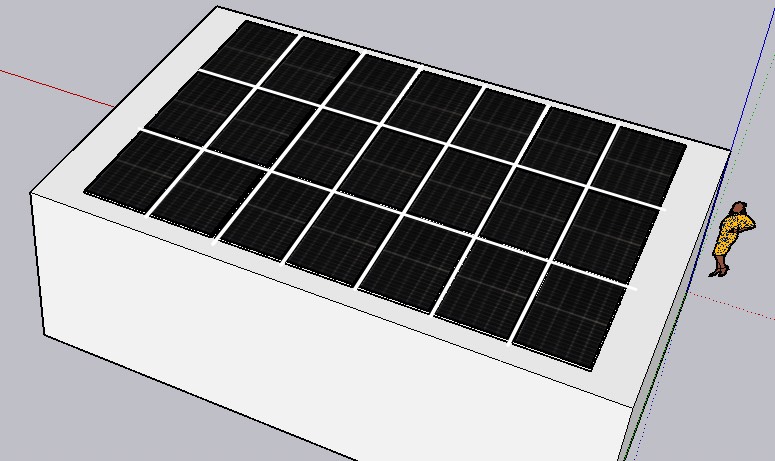
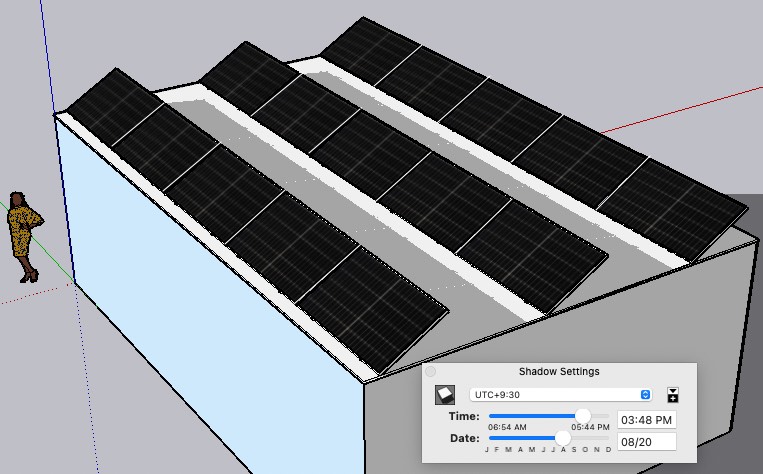
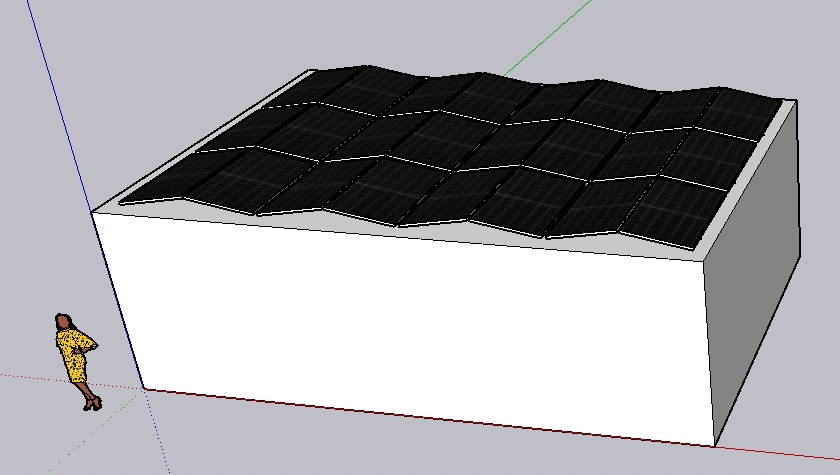
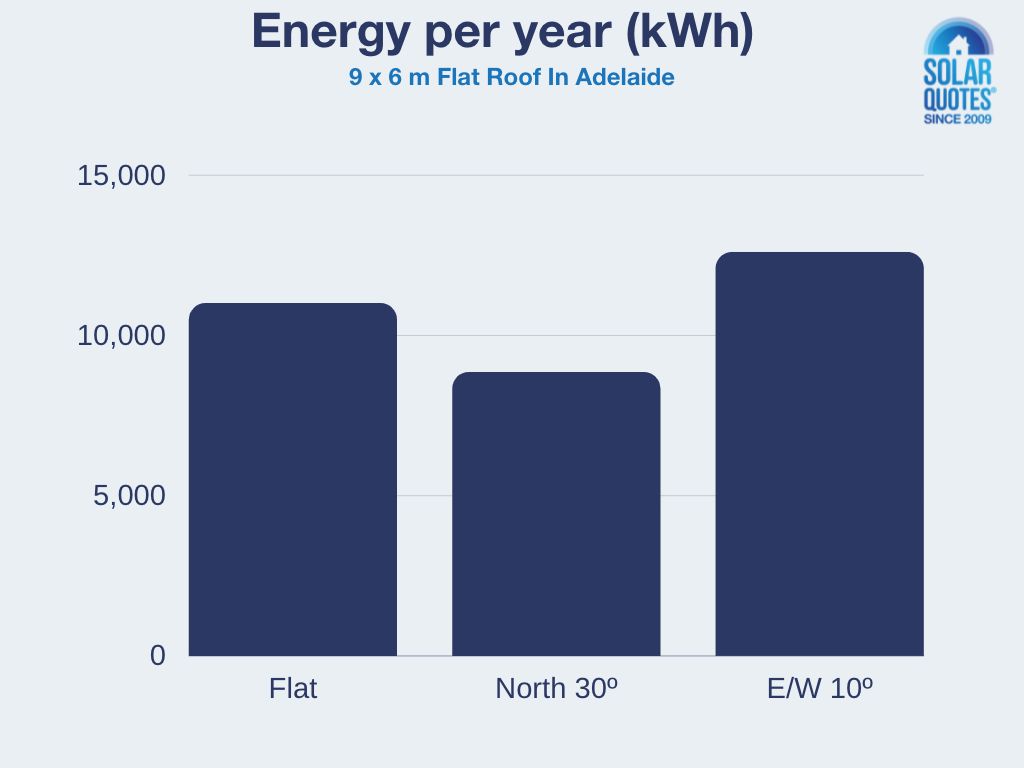
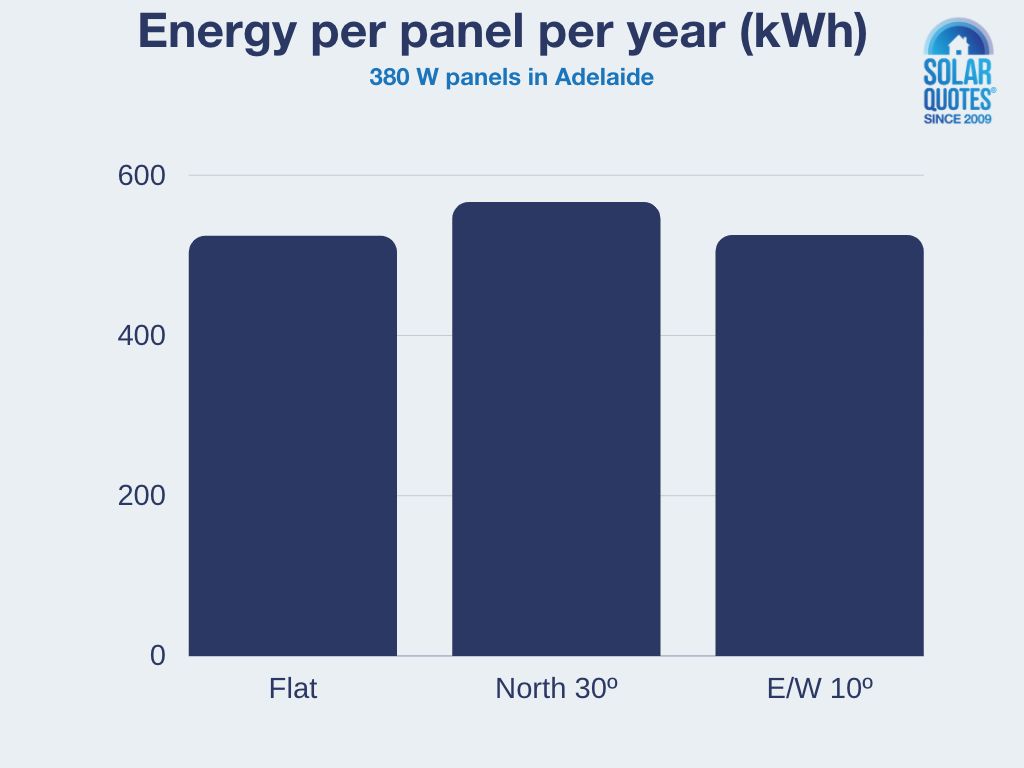
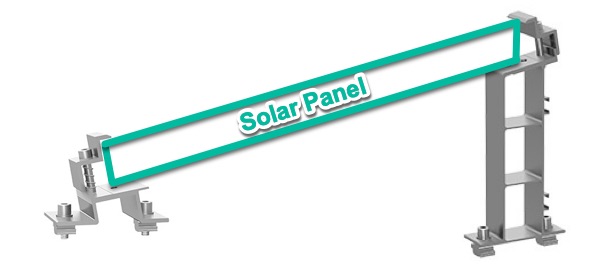
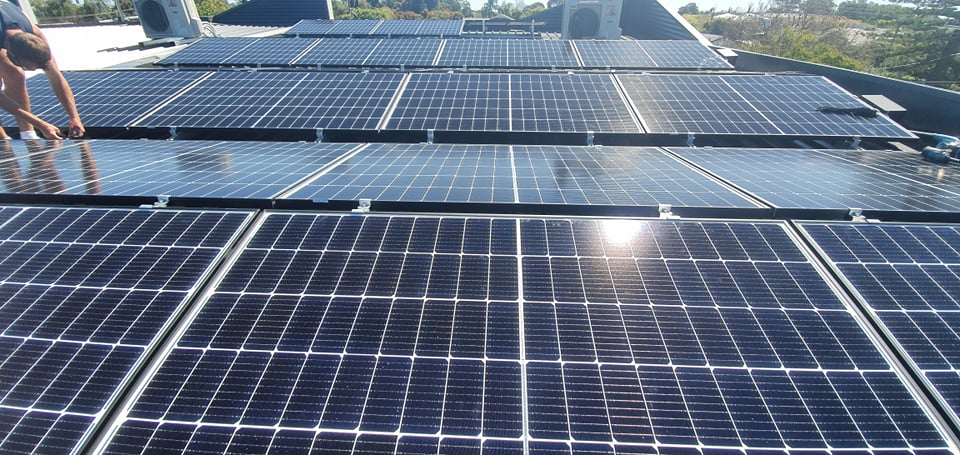
 RSS - Posts
RSS - Posts



Finn, thanks for the thoughtful piece. It would be good to be able to compare the production by time of day curves for each option as most peoples consumption is in the morning and early evening with cooking etc. and east west should produce more power when it is most needed. Last point in WA at least there is a very poor feed in tariff which rises later in the afternoon so any unused power produced later in the day would attract the higher feed in tariff.
I have been installing Solar Water Siphon Clips on Panels Lower than 10 Deg with Great Results, Cost against tilts are much less at $2.20 Per Clip Per Panel.
Love this Part 🙂
“A minimum tilt of 10° is recommended to take advantage of self-cleaning during rain events. Where panels are installed at a tilt angle less than 10°, the customer shall be advised about the need for more frequent cleaning of the modules, and this should be included in the recommended maintenance schedule.”
“need more frequent cleaning”? Thought Panels were self cleaning, That’s what installers Say, Especially with All the Rain we Are getting at the moment!
Funny How I can Go to a Solar P.V System the day after we get 50mm of Rain and prove how dirty they still are!
A minor correction: In Darwin, we get consistent strong sunlight every day EXCEPT for just over 3 months each year, when we get big funky clouds and heavy rains.
That means we don’t get heavy rains, and in fact we get hardly ANY rain, for more than 8 months each year.
Anyone who wants high PV production has no choice but to clean the bird poop, bat poop and dust from the panels throughout the dry season.
It’s also worth keeping in mind that with the rain comes very high plant growth rates, so regular pruning is also likely to be necessary.
Great Point 🙂 No Where in the World can you claim Rain will clean your Panels!
https://www.solarquotes.com.au/blog/solar-panel-cleaning/
I’d like to see a decent article on the potential wind loading issues that tilt racking and solar panels cause on house structures. We have 44 panels on a 30 degree tilt on a N3 rated house. I do wonder whether this is a ticking time bomb when the next big storm hits.
Fronius did a whitepaper on this topic and recommended that you can connect all the east west panels to just one mppt tracker instead of 2. Also helioscope has an article that shows that east west array are azimuth independent. You can pretty much lay them in any azimuth orientation.
We install solar panels on RV’s so all the installs are flat. We have also installed a few off grid houses where the roof was oriented to the nth at around 30* and flat roof installs where we used the tilt frame method to get the 30* and facing nth. All the panels need cleaning properly every 6 mths or so, rain water isn’t pure and it leaves a build up of scale/scum on the panel and a dirt rigid around the frame that if left to build up, actually damages the edges of the modules.
A scrub over regularly with truck wash and hosed off works well, but a polish with car polish really works well, even when the panels are flat mounted, the scale and scum just can’t get a hold and beads off with even a slight breeze
T1 Terry
Very interested in your points about cleaning panels.
Given the costs of getting a contractor to clean panels, what are your recommendations?
For instance:
1. A hard jet, or a spray plus soft broom?
2. Once every two years?
3. Any variation on procedure for an installation 6 yrs old?
The installation that I monitor is a 30kW array.
I get daily reports on performance, and from interest, summarise each year’s performance for the Board.
Hi David
If there is any risk of a fall, get a professional cleaner in. They should be able to handle it safely.
Otherwise, you can clean the panels when they are obviously dirty. You can check with the panel manufacturer for their recommendations, but generally speaking high pressure sprays should not be used as they may damage the panel seals. When you spray water on them it should fall like rain. Let water fall on them, allow any bird poop soften up, and then let water fall on them again. If water alone is not enough you can use a clean soft cloth. A soft broom is not ideal but can provide reach where it would otherwise be dangerous to get closer. No change for the age of the panels.
Hopefully, in the location they’re in, the elements will keep them clean enough so you’ll have have to bother doing it.
What about the council approval cost when installing panels over 10cm above the roof ? Would this racking system trigger this building rules ?
The first obvious point is that options 1 & 3 totally cover the roof, making it very difficult to do the install, let alone to manouvre arund to THOROUGHLY clean the panels with a hose and broom etc. You should be recommending layouts etc. with BOTH those factors in mind.
Also, I do not see how you can fit an extra 3 panels, just because you have a modest E/W tilt. \and if you build inmore tilt, then you would need to allow spacing to avoid overshadowwing as per option 2.
Further, If your sample roof and the size of each panel is the same size forALL THREE options, your comment about additional spacing for option 2 does not seem to be pictured as you suggest in your commentary.
Could you please comment/explain?
This article is based on a roof that points true north. Ours points 25 degrees to the east of north. We’re in Canberra and the roof pitch is 2 degrees. Do you think the east-west tilt would still be a good alternative with the ‘non-true north’ angle we have?
Hans van Holst also raised this too. I am also interested if it is OK to have no space between the rows to allow access for cleaning or repairs to the panels (or indeed repairs to the roof if there were a leak in the roof for instance). I would have thought this would be needed and that there would be a standard width of free space required between rows. Of can you walk on the panels for access (even when they have a tilt)?
I have found conflicting information about the installation of panels on racking. One council web site states they must be installed parallel to the roof to be an exempt development. Another states the highest point must not be geater than 500mm above the roof surface.
Many installer websites include links to “Standard Instrument—Principal Local Environmental Plan (2006 EPI 155a)”. I couldn’t find any specific reference to solar panels in this.
Can anyone enlighten me re NSW requirements? No one seems to have responded to a question like this higher on the page.
During periods of low angle sun during the winter, panels tilted at very high angles can add considerably to the shading of neighbouring property north sides. This E/W arrangement would help considerably in this situation.
So apart from the additional output, you can an asthetics and a shading advantage to this E/W arrangement.
All you guys never see simple. If you have under 10 Deg Panels put Water Siphon Clips on! If you spent the money on Panels with Gutters, Good for you!
If you happen to know of any sources of information on the performance of water clips over time, I’d be very interested in them.
I have finally finished my test of the siphon clips.
I bought two clips in 2022 (from ebay).
Then I promptly forgot about them.
Finally installed them on one panel in April 2023 (cleaned two panels, one with a clip at either end and one for comparison). Panels are at a very low angle (less than 5 degrees).
Then I forgot about them again.
Just had a look today. The dirt accumulation between the panel with siphon clips and the panel without is the same (non scientific assessment). However, where the clips are, there is more dirt accumulation.
So I would say that adding siphon clips to low angle panels is not worthwhile.
I have photos and can share with Ronald/solarquotes if requested.
In the evaluations I have done, the tilted arrangement still wins over the E-W racking for winter output. Why does this matter? Because if you are export limited, don’t get FIT at all, or the FIT is 2c/kWh (Perth) – then your aim is generally to maximise self consumption over the year. If your 10kW panels system installed on a 3deg north facing roof generates 22kWh/d avg in winter but 60kWh/d in summer, that is not generally achieving that outcome. Maybe 20kWh/d of the summer output may be going to the grid almost for nothing and you may be pulling 10-20kWh/d from the grid in winter. E-W tilt at 10deg will not improve the winter output significantly. Changing to 30deg tilt and 7kW panel may result in maybe 10% more output in winter and still plenty in summer.
Also need to consider the additional reduction in winter output on an E-W if you can’t put them on separate MPPTs.